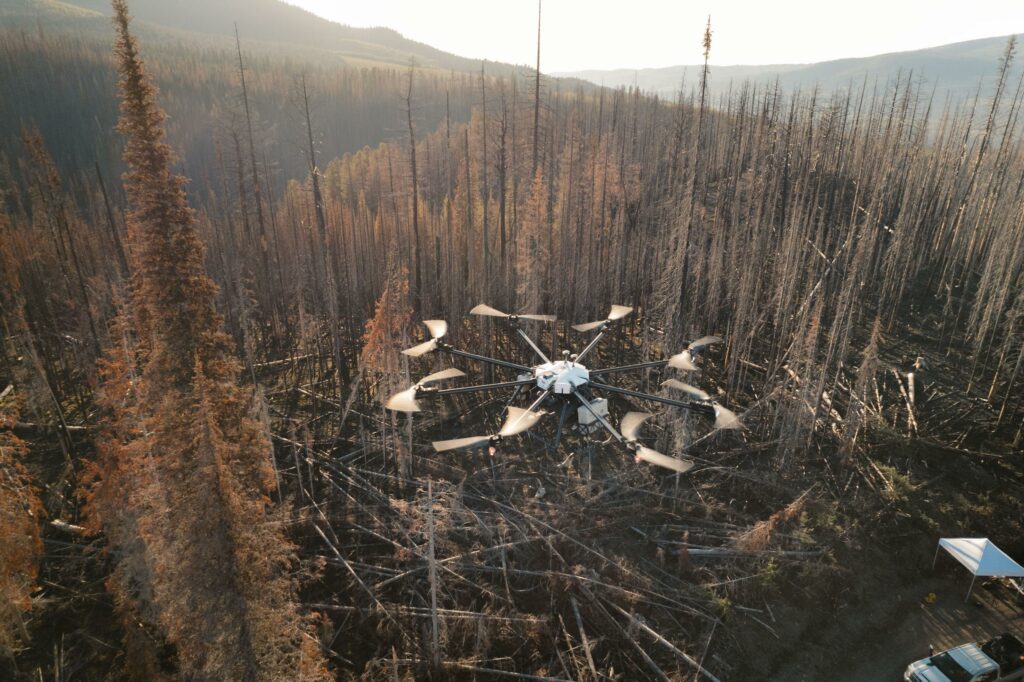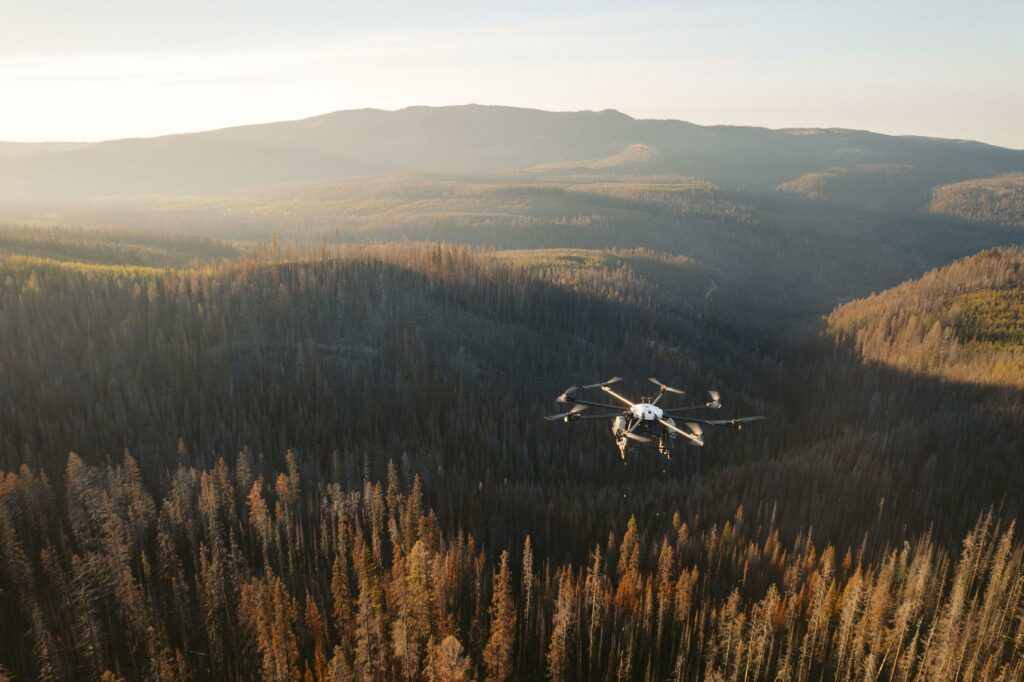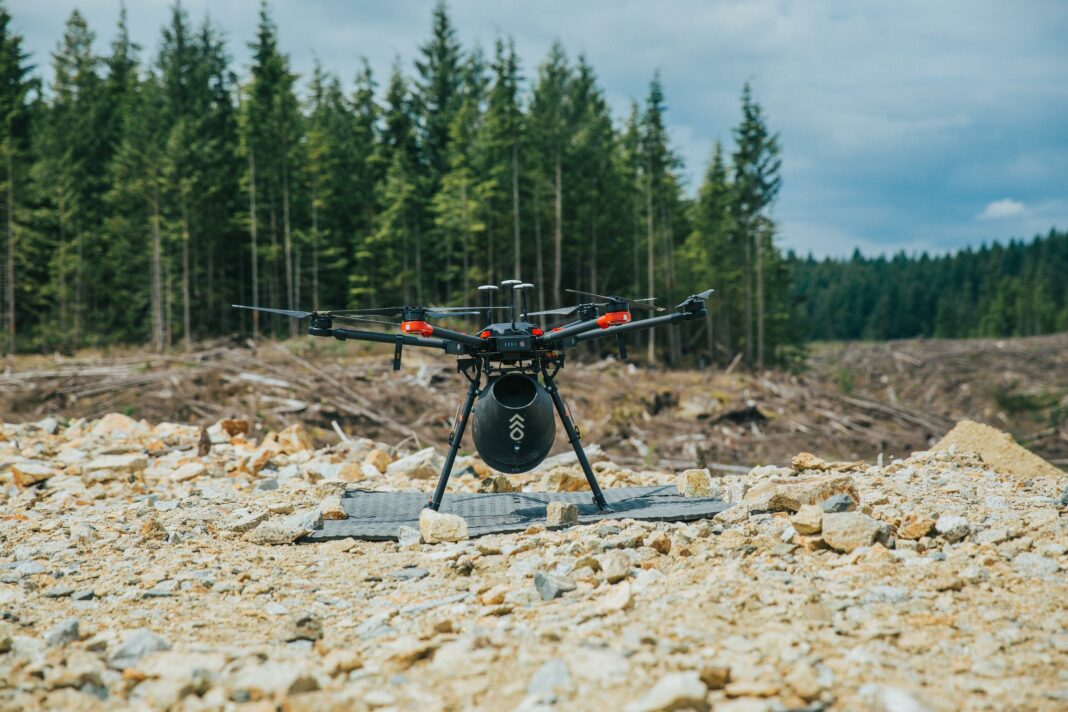A Mississauga-based company is using drones for massive reforesting efforts after wildfires.
Cameron Jones pours a little water into a small beaker and drops a little brown tablet the size of a marble into the liquid. Within seconds, the pellet starts to swell and dissolve into what it is: a carefully engineered blend of nutrients that seeds need to germinate. A couple of minutes later, the dirty water has become a sort of gelatinous brownish goo. I stick my finger in it. It feels like custard, or maybe pudding.
“We fire these seed pods about a centimetre into the ground, and when it rains, the pods swell up like this,” explains Jones. “They’ll hold the water for a couple of months, long enough for the seedling to germinate and start growing.”
Jones is the chief operating officer of Flash Forest, a Mississauga-based company that uses drones to plant trees — or, more accurately, millions of the same seed pods whose magic trick I just witnessed — in wildfire-ravaged areas. Its mission is to plant a billion trees by 2028, and if its technology takes off internationally, which is very much part of the company’s plans, Flash Forest could be an important contributor to the fight against runaway climate change.
Given that trees are natural carbon dioxide absorbers, it’s hard to overstate the potential impact of Flash Forest’s technology.
In 2019, Cameron’s brother Bryce, then an engineering student in Toronto, started what would become Flash Forest with an off-the-shelf commercial drone modified to drop bare tree seeds onto the ground. Having worked as a tree planter, he knew how laborious the planting process was and how challenging it would be to replant the huge areas that were being decimated by Canada’s annual wildfires, which due to climbing global temperatures are becoming hotter, more widespread, and more frequent. By 2020, Bryce rounded out the team with his brother Cameron; Angelique Ahlström, Bryce’s fiance and now his wife and the company’s chief strategy officer; and Andrew Lauder, a graphic designer who is a childhood friend of Cameron’s. The four launched a Kickstarter campaign that destroyed their modest $10,000 target by raising $108,713 from just over 1600 supporters.
“The Kickstarter changed our world,” recalls Cameron. “We were extremely excited. We bought a drone but we still didn’t have enough money to pay ourselves or anything. $100,000 doesn’t really get you that far.”
But family and friends chipped in another $400,000 that allowed the team to hire more staff, rent a barn in which they manufactured 30,000 seed pods, and complete their inaugural season of planting. Their efforts attracted a flurry of favourable media coverage that led to venture capital funding to the tune of roughly $5 million.
Since 2019, the team has tried several methods to get seeds into the ground. At first, they dropped bare seeds from the drone, but they just lay on top of the soil and didn’t germinate. Later they wrapped the seeds in a sort of gelatin capsule, then embedded them in pucks of biochar (essentially, charcoal). Each approach had its merits, but none was particularly successful at getting seedlings to grow, and there were too many losses.
But now they think they’ve got it right. The newest seed pods, the marble-sized ones Cameron showed me, are dry, aerodynamic, and contain essential bacteria and nutrients. They absorb and hold water long enough to allow the seed to grow, even in drought conditions. Critically, each pod receives a mycorrhizae blend (mycorrhizae are fungi that help roots take up nutrients). For the drones, the company’s engineers have developed a mechanical “embedder” that fires seed pods at a velocity of 200 feet per second about a centimetre into the ground — the perfect depth to allow the pod to absorb rainfall and enable the seeds to sprout and grow roots.

“Those are two of our biggest breakthroughs,” explains Cameron. “Figuring out how to keep a water retention agent into a dry pod that could then be fired from the drone into the ground. Once we had those two things, then our germination rates started going way up.”
Today, after a recent injection of $11 million from investors including Circular Investments, Telus Pollinator, and Our Crowd (based in Israel), Flash Forest has about 30 employees in Toronto, Hamilton, Edmonton, and Vancouver. In summer, the company’s field teams visit prospective planting sites to collect cones that carry conifer seeds that are later embedded in the seed pods, and soil samples that help determine the seed-pod recipes for each site. The firm uses satellite imagery and GIS mapping to identify planting sites (i.e., where the hottest fires obliterated a forest) and artificial intelligence to review weather and geographic data to determine the optimal planting sites and times. The firm is also working on software that uses AI to predict, with remarkable accuracy, where future wildfires are most likely to happen. “Last year in British Columbia, every single site we’d identified in advance burned,” says Cameron.
The company has engineered a patent-pending pod production machine that can crank out 90 pods per second — 500,000 per day — and another patent-pending device that inserts seeds into the pods. Its newest drones are about 14 feet wide, carry over 10,000 seed pods, and shoot 16 seed pods per second into the ground. If the early versions of the embedder were single-shot pistols, the latest ones are machine guns. “We’re always iterating,” says Cameron.
The company has reforestation projects underway across Canada, each supported by grants from companies like Telus and Air Transat, who through sponsorship of Flash Forest hope to further their corporate social responsibility (CSR) goals.

Given that trees are natural carbon dioxide absorbers, it’s hard to overstate the potential impact of Flash Forest’s technology. In 2023, the world recorded its hottest year ever and Canada had its worst-ever wildfire season. For months, blazes sparked mostly by summer lightning strikes and prolonged by heat domes scorched forests in B.C., Alberta, the Northwest Territories, Ontario, the Maritimes, and, most of all, Quebec. They enveloped much of North America in hazy smoke that made breathing unpleasant and forced thousands of people in the fire zones from their homes, sometimes for weeks. By October, some 6,595 fires had transformed approximately 18.4 million hectares of boreal forest, an area larger than Greece, into wastelands of ash. Forest fires in Canada typically burn roughly 2.5 million hectares annually.
In many areas, once firefighters or rains douse the blazes, tree-planting crews are dispatched to plant seedlings that, over time, will replace the trees lost to fire. It’s gruelling work. In ideal conditions and reasonably accessible terrain, a skilled tree planter working virtually non-stop can plant between 1,000 and 3,000 seedings daily.
But, as Bryce Cameron recognized when he started Flash Forest, there’s no way human tree planters can replant areas as large as the ones that have been incinerated in Canada in the last few years. The areas are too vast, and many of the blazes were in remote locations where sending tree-planting crews would be neither financially feasible nor safe due to unstable charred trees and toxic ash.
There’s no way human tree planters can replant areas as large as the ones that have been incinerated in the last few years. The areas are too vast, and many were in remote locations where sending tree-planting crews is neither financially feasible nor safe. Those areas are Flash Forest’s sweet spots.
Those areas are Flash Forest’s sweet spots. Its drones can reach many of these severely burned areas with minimal risk and reseed them quickly, since one or two operators can direct multiple drones simultaneously and plant as many as one million seed pods per day. These operations need to happen within one or two years, before the soil compacts and post-fire succession plants like fireweed and brush grass can establish themselves and make planting more difficult. Fortunately, unlike seedlings, seeds can lie dormant in this scorched earth bereft of minerals and organic matter until the temperature and moisture conditions are right for them to grow.
“That’s where it becomes really important to have mycorrhizae, the nutrients, and the water-holding capability surrounding the seed,” says John Innes, a professor in the faculty of Forestry at the University of British Columbia, who over the years has been an adviser to Flash Forest. “And that’s what they’re doing with the pellets that they’re firing.”
The urgency of replanting these burnt-out areas of Canada’s boreal forest can’t be overstated. Forests influence climate patterns, prevent erosion, and are home to countless animal and insect species that contribute to the world’s biodiversity. When they burn, all this is lost. So, sometimes, are people’s homes and livelihoods. Also, thanks to the grim combination of climate change-induced wildfires, increasing annual temperatures, infestations of insects like Gypsy moths and various types of beetle, and an inability to replant burnt areas fast enough, Canada’s boreal forests have become not a carbon sink, but a net carbon producer.
And this sort of wildfire devastation isn’t confined to Canada. Flash Forest has had calls about its technology from interested parties in the U.S., Australia, South America, and Asia. “It seems like we’ve had inquiries from everywhere,” says Cameron. “Because everyone needs solutions. Everyone’s experiencing wildfires like never before, and they need solutions fast.”
“There’s a lot of people talking about [the need to plant trees],” adds Professor Innes. “Flash Forest is actually going out and getting trees in the ground. Those trees will be growing. And I think they’re doing a pretty good job as a result. It’s a drop in the ocean, but it’s still important. Ultimately, it will become a very significant carbon sink. Provided we don’t burn them.”



Brilliant minds at work bringing innovative solutions to serious issues. I am so immensely impressed by this solution to combat climate change. Proud as He!! That it’s a Canadian organization.